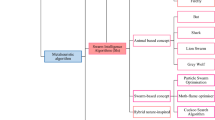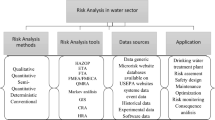Abstract
In the context of water as an economic good, from the use of water, one can derive a value, which can be affected by the reliability of supply. On-demand irrigation systems provide valuable water to skilled farmers who have the capacity to maximize economic value of water. In this study, simultaneous optimization of on-demand irrigation network layout and pipe sizes is considered taking into account both investment and annual energy costs. The optimization problem is formulated as a problem of searching for the upstream head value, which minimizes the total cost (investment and energy costs) of the system. The investment and annual energy costs are obtained in two separate phases. Max–Min ant system (MMAS) algorithm is used to obtain the minimum cost design considering layout and pipe diameters of the network simultaneously. Clement methodology is used to determine flow rates of pipelines at the peak period of irrigation requirements. The applicability of the proposed method is showed by re-designing a real world example from literature.




Similar content being viewed by others
Referencing
Afshar, M. H. (2001). An element-by-element algorithm for the analysis of pipe networks
Afshar MH (2006) Application of a max–min ant system to joint layout and size optimization of pipe networks. Eng Optim 38(3):299–317
Afshar MH (2007) Evaluation of selection algorithms for Simultaneous layout and pipe size optimization of water distribution networks. Sci Iran 14(1):23–32
Afshar MH (2008) Layout and size optimization of tree-like pipe networks by incremental solution building ants. Can J Civ Eng 35(2):129–139
Alandi PP, Martín-Benito JMT, Alvarez JO, Martínez MC (2001) Design of water distribution networks for on-demand irrigation. Irrig Sci 20(4):189–201
Alandi PP, Carrión Pérez P, Ortega Álvarez JF, Moreno Hidalgo MÁ, Tarjuelo Martín-Benito JM (2005) Pumping selection and regulation for water-distribution networks. J Irrig Drain Eng 131(3):273–281
Alandí PP, Álvarez JO, Martín-Benito JT (2007) Optimization of irrigation water distribution networks, layout included. Agric Water Manag 88(1):110–118
Cembrowicz RG (1992) Water supply systems optimization for developing countries. In Pipeline systems (pp. 59–76). Springer Netherlands
Clément R (1966) Calcul des débits dans les réseaux d’irrigation fonctionnant à la demande. La Houille Blanche 5:553–576
Córcoles JI, Tarjuelo JM, Carrión PA, Moreno MÁ (2015) Methodology to minimize energy costs in an on-demand irrigation network based on arranged opening of hydrants. Water Resour Manag 29(10):3697–3710
Davidson JW, Goulter IC (1995) Evolution program for design of rectilinear branched networks. J Comput Civ Eng 9(2):112–121
Díaz JR, Luque RL, Cobo MC, Montesinos P, Poyato EC (2009) Exploring energy saving scenarios for on-demand pressurised irrigation networks. Biosyst Eng 104(4):552–561
Díaz JR, Montesinos P, Poyato EC (2012) Detecting critical points in on-demand irrigation pressurized networks–a new methodology. Water Resour Manag 26(6):1693–1713
Dorigo M, Maniezzo V, Colorni A (1996) Ant system: optimization by a colony of cooperating agents. IEEE Trans Syst Man Cybern B 26(1):29–41
García IF, Díaz JR, Poyato EC, Montesinos P (2013) Optimal operation of pressurized irrigation networks with several supply sources. Water Resour Manag 27(8):2855–2869
García IF, Moreno MA, Díaz JR (2014) Optimum pumping station management for irrigation networks sectoring case of Bembezar MI (Spain). Agric Water Manag 144:150–158
Kashkooli BS (2009) Simultaneous layout and pipe size optimization of pressurized irrigation networks using Meta heuristic techniques (published doctoral thesis (in Persian)). University of tarbiat modares, Tehran, Iran
Kashkooli BS and Monem MJ (2009) Simultaneous layout and pipe size optimization of pressurized irrigation water distribution networks using hybrid ACO/LIDM Method, Proceeding of the International Conference on Water Resources (ICWR 2009), Bayview Hotel, Langkawi, Kedah, Malaysia, May 26–27, 2009
Labye Y (1981). Iterative discontinuous method for networks with one or more flow regimes. In Proceedings of the international workshop on systems analysis of problems in irrigation, drainage and flood control. New Delhi (vol. 30, pp. 31–40)
Labye Y (1988) Design and optimization of irrigation distribution networks FAO irrigation and drainage paper 44. FAO, Rome
Lamaddalena N & Sagardoy JA (2000) Performance analysis of on-demand pressurized irrigation systems (No. 59). Food & Agriculture Org
Liang T (1971) Design conduit system by dynamic programming. J Hydraul Div 97(3):383–393
Moradi-Jalal M, Marino MA, Afshar A (2003) Optimal design and operation of irrigation pumping stations. J Irrig Drain Eng 129(3):149–154
Moreno MA, Alandi P, Ortega JF, Tarjuelo J (2007) New methodology to evaluate flow rates in on-demand irrigation networks. J Irrig Drain Eng 133(4):298–306
Navajas JN, Montesinos P, Poyato EC, Díaz JR (2012) Impacts of irrigation network sectoring as an energy saving measure on olive grove production. J Environ Manag 111:1–9
Rossman LA (1994) EPANET User Manual, Risk Reduction Engineering Laboratory, US Environmental Protection Agency, Cincinnati, OH, p 107
Schaake JC & Lai D (1969) Linear programming and dynamic programming applications to water distribution network design. Report 116, Hydrodynamics Laboratory, Department of Civil Engineering
Stützle T, Hoos HH (2000) MAX–MIN ant system. Futur Gener Comput Syst 16(8):889–914
Walters GA, Smith DK (1995) Evolutionary design algorithm for optimal layout of tree networks. Eng Optim 24(4):261–281
Author information
Authors and Affiliations
Corresponding author
Ethics declarations
Conflict of Interest
No conflict of interest.
Rights and permissions
About this article
Cite this article
Masoumi, M., Kashkooli, B.S., Monem, M.J. et al. Multi- Objective Optimal Design of on- Demand Pressurized Irrigation Networks. Water Resour Manage 30, 5051–5063 (2016). https://doi.org/10.1007/s11269-016-1468-6
Received:
Accepted:
Published:
Issue Date:
DOI: https://doi.org/10.1007/s11269-016-1468-6




